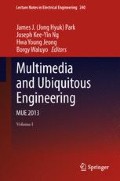Abstract
Nowadays E-learning is widely used in teaching and training purposes, and it also facilitates conventional classroom-based learning activities with advanced information technologies. On the other hand, such advanced information technologies also make digital learning content easily applied to some acknowledged learning theories, such as Behaviorism, Cognitivism, Constructivism, and make e-learning being more practical and diverse in many pedagogical purposes.
Access this chapter
Tax calculation will be finalised at checkout
Purchases are for personal use only
References
Amory A, Naicker K, Vincent J, Adams C (1999) The use of computer games as an educational tool: identification of appropriate game types and elements. Br J Educ Technol 30(4):311–321
Bae Y, Lim J, Lee T (2005) Work in progress—a study on educational computer, games for e-learning based on activity theory. In: Frontiers in education, 2005. FIE ‘05. Proceedings 35th annual conference, pp F1C-18
Gee JP (2003) What video games have to teach us about learning and literacy. Palgrave Macmillan, New York
Koster R (2005) A theory of fun for game design. Paraglyph Press, Scottsdale
Kuutti K (1995) Activity theory as a potential framework for human-computer interaction research. In: Nardi B (ed) Context and consciousness: activity theory and human-computer interaction. MIT Press, Cambridge, pp 17–44
Lynch K (1960) The image of the city. MIT Press, Cambridge
Malone TW, Lepper MR (1987) Making learning fun: a taxonomy of intrinsic motivations for learning. Aptitude Learn Instr 3:223–253
Sandford R, Williamson B (2005) Games and learning: a handbook. NESTA Futurelab, Bristol
Siegel AW, White SH (1975) The development of spatial representations of large-scale environments. Adv Child Dev Behav 10:9–55
Squire K (2005) Changing the game: what happens when video games enter the classroom? J Online Educ
Author information
Authors and Affiliations
Corresponding author
Editor information
Editors and Affiliations
Rights and permissions
Copyright information
© 2013 Springer Science+Business Media Dordrecht(Outside the USA)
About this paper
Cite this paper
Wang, TH. (2013). Housing Learning Game Using Web-Based Map Service. In: Park, J., Ng, JY., Jeong, HY., Waluyo, B. (eds) Multimedia and Ubiquitous Engineering. Lecture Notes in Electrical Engineering, vol 240. Springer, Dordrecht. https://doi.org/10.1007/978-94-007-6738-6_81
Download citation
DOI: https://doi.org/10.1007/978-94-007-6738-6_81
Published:
Publisher Name: Springer, Dordrecht
Print ISBN: 978-94-007-6737-9
Online ISBN: 978-94-007-6738-6
eBook Packages: EngineeringEngineering (R0)

